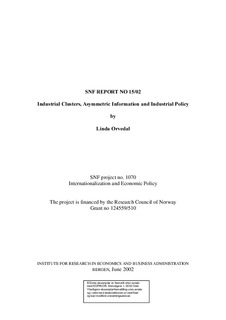| dc.contributor.author | Orvedal, Linda | |
| dc.date.accessioned | 2006-08-08T08:11:55Z | |
| dc.date.available | 2006-08-08T08:11:55Z | |
| dc.date.issued | 2002-06 | |
| dc.identifier.isbn | 82-491-0202-9 (trykt versjon) | |
| dc.identifier.issn | 0803-4036 | |
| dc.identifier.uri | http://hdl.handle.net/11250/164771 | |
| dc.description.abstract | Abstract Recently there has been some attention on the issue of industrial clusters and industrial policy claiming that there are arguments in favour of subsidising special industries in order to stimulate industrial agglomeration. An important objection against such a selective industrial policy is that the government needs full information about the industries to be able to pick the winners. But often the government does not know whether the industry is a cluster or not. If the policy towards a cluster is more favourable than the policy towards other industries, all industries will have incentives to allege to be clusters. The problem for the government is to identify the true clusters from the ordinary industries. This paper attempts to shed some light on the problem of industrial policy and industrial clusters when there is asymmetric information between the government and the industry. We show that a subsidy contingent of a certain activity level will create a separating equilibrium. | en |
| dc.format.extent | 133724 bytes | |
| dc.format.mimetype | application/pdf | |
| dc.language.iso | eng | en |
| dc.publisher | SNF | en |
| dc.relation.ispartofseries | Report | en |
| dc.relation.ispartofseries | 2002:15 | en |
| dc.subject | asymmetric information | en |
| dc.subject | industrial clusters | en |
| dc.subject | industrial policy | en |
| dc.subject | scale economies | en |
| dc.title | Industrial clusters, asymmetric information and industrial policy | en |
| dc.type | Research report | en |
